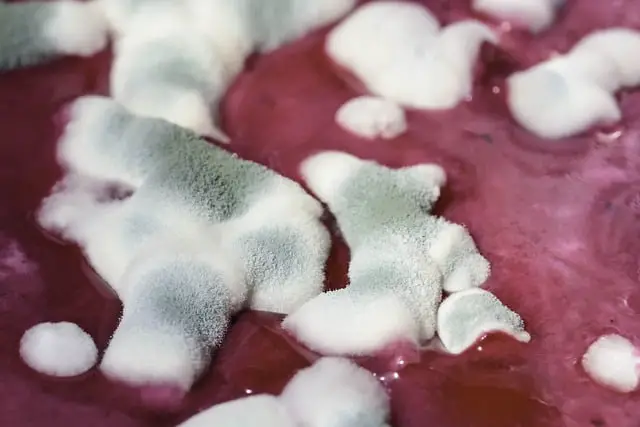Mold growth in your home is never a good thing. And in RVs, mold can be especially insidious.
These fungal spores can find their way into every crevice of your RV camper, not only making an ugly mess to clean up, but creating a potential threat to your health.
What Is Mold?
Mold, simply, is fungus. These particular kinds of fungi proliferate best is damp environments and, if left untreated, grow into larger mold swaths of black, green, orange, white, or even purple.
There are over 120,000 documented types of fungi in the world, luckily, only a few species show up in our RVs!
The following are the four most common types of mold found in homes:
| Mold Type | Color | Texture |
|---|---|---|
| Alternaria | Black, Brown, or Grey | Velvety |
| Aspergillus | Black with White/Yellow Under Surface OR Yellow/Green with Gold/Red Under Surface | Powdery |
| Cladosporium | Olive Green OR Brown | Suede-like |
| Penicillium | Blue OR Greenish | Velvety to Powdery |
| Mildew | White, Grey, OR Yellowish; If left untreated, can become black | Powdery, Fluffy |
Mold can be found in any moist, damp environment, in both warm or cool temperatures.
Fungi proliferates by moving through the air and landing on damp surfaces: If the surface is hospitable to fungal life, more spores will begin to take hold and continue to grow.
Although we encounter and interact with fungi everyday- breathing in tiny spores when we go outside, and even move about our homes- this regular exposure is typically harmless.

Mold becomes a problem, however, when it starts to take over areas we inhabit: Our bathrooms, bedroom, windows, laundry rooms, carpet, couches… Anywhere that traps moisture.
Once mold starts to set and spread, you need to be vigilant about removing it from your RV.
Is Mold and Mildew the Same?
Mildew and mold are fungi, however, mildew is a less intrusive kind of fungal growth.
Like mold, mildew grows due to moisture in the environment; This is why most of us have had to deal with mildew in our bathrooms and showers!
Unlike mold, however, mildew is relatively easy to remove: Put on some cleaning gloves, grab a bottle of mildew remover, and a scrubber, and scrub it all off.
Mold, in contrast, encroaches on areas and can take a bit more elbow grease and time to remove fully.
How to Remove Mold from RV Walls

There are numerous ways to remove mold from your RV: DIY mixtures and chemical treatments. Here, we’re focusing on DIY mixtures for hard surfaces: Cheap, easily made, and efficacious.
Remember to open all the windows in your RV for proper ventilation prior to removing any mold, and always wear gloves for protection.
Bleach and Water
Bleach is a strong mold killer. It is effective on hard, non-porous surfaces like counter tops, tile, and glass, however it cannot remove mold from areas like wood.
In a bottle, bowl or bucket, use a ratio of one cup bleach to one gallon of water.
Using a sponge, clean the affected area, removing mold. Once the mold is gone, wipe away bleach with water and non-bleach-soaked sponge (especially if you have pets or children who are likely to touch the treated area!)
Understand that although a powerful cleaner, bleach is also caustic and corrosive. The fumes from bleach can be dangerous when breathed in; If you do plan on using this mixture, make sure any pets and children are out of your RV before you begin!
Grapefruit Seed Extract and Water
Grapefruit seed oil is a near-odorless, natural disinfectant, and is a good weapon against mold.
Like tea tree oil, grapefruit seed oil is known for its antibacterial, antiviral, and antifungal properties, making it highly effective against mold growth in your RV.
In a spray bottle, pour two cups of warm water and 25-30 drops of grapefruit seed extract.
Spray the solution on the affected area, and let the solution stand for at least 30 minutes before wiping away.
Tea Tree Oil and Water
Like grapefruit seed extract, tea tree oil is a highly effective way to remove mold naturally from your RV.
Tea tree oil is not only a natural antibacterial, but also an antiviral, and antifungal!
In a spray bottle, pour one teaspoon tea tree oil for every cup of water. Screw on cap and shake mixture.
Spray affected area and let sit for at least 30 minutes, then wipe away.
Caution! Tea tree oil is known to be toxic to pets! Make sure to remove your pets prior to spraying tea tree oil in your RV, and once mold is removed, wipe away with water to make sure the area is safe for your pets to return.
Vinegar and Tea Tree Oil
In a spray bottle, pour 1 cup white distilled vinegar and 15-20 drops of tea tree oil. Screw on the cap and shake the mixture.
Spray on affected surfaces and let sit for at least 30 minutes. With mold, the longer you let the mixture do its magic, the better. Mold likes to hang around and grow back; Making sure to not only remove the mold but also kill it, is the goal.
When ready, wipe mold and mixture away.
Remember, tea tree oil is highly toxic to pets, so make sure to remove your pets from your RV prior to using this mixture, and clean the treated surface with water before bringing you pet back inside!
How to Prevent Mold in Your RV (Reduce Moisture)

Preventing mold regrowth is essential to keeping your RV clean and maintaining a healthy environment for you, your family, and pets.
Because moisture is the main culprit for fungal growth, reducing moisture will help impede its return.
Ways to Reduce Moisture in Your RV
- Fix Any Leaks ASAP
- Caulk Windows, Door Trim (anywhere water may drip through)
- Open Windows (air flow / ventilation)
- Run Ceiling Fans (air flow / ventilation)
- Run the Air Conditioner (removes moisture from air)
- Moisture Absorbers
Fix Any Leaks. Leaks are a very common occurrence in RVs, and they can easily lead to mold growth and damage to the RV’s structure.
Make sure to check for leaks often, and repair any as soon as possible. Water damage and fungal growth are two problems that can (and do!) cause severe damage.
Caulk Windows, Door Trim. Caulking vulnerable areas often is important for RV owners in order to avoid water damage and mold growth.
Checking for worn seams around your RV windows and door trim is essential maintenance that should be done regularly.
It may require a little elbow grease, but consistent maintenance can help you avoid water damage, moisture, and bar mold from growing.
Open Windows. This can help keep moisture down inside your RV in most circumstances.
RVs are small spaces, so opening windows before performing activities that increase moisture like cooking, boiling water, or taking a shower will help keep moisture down.
Run Ceiling Fans. RVs are equipped with ceiling fans that can either pull air in, or pull air out.
Setting the fans to pull air out of your RV can help keep moisture out of your living space.
Run the Air Conditioner. Air conditioners work by taking in the hot air from its environment, converting that gas into liquid, then back into a gas, cooling down your RV.
When the hot air- and moisture- is sucked into the AC system, this dries out the RV and lessens opportunities for mold spores to take hold in your RV!
Moisture Absorbers. Moisture absorbers can be a great help in keeping moisture down in your RV.
DampRid hanging moisture-absorbers are easy-to-use products to help keep mold and mildew growth down!
To use, just hang in your RV’s closet, bathroom, or anywhere that moisture is likely to be a problem.
The white crystals inside the DampRid baggie will absorb moisture in the environment, and over time, fill the bag.
When the absorption crystals are dissolved and the baggie is filled with moisture, you’ll dispose of the bag and replace with a new DampRid moisture absorber.
If you have problem areas in your home and/or live in a humid climate, moisture absorbers are a helpful product to have in your RV.
Conclusion. Mold is an especially insidious problem that affects many RVs.
Although notoriously difficult to remove, maintaining a living space free of fungal growth is important for the health of RVer, as well as the structural integrity of the RV itself.
Living in an RV, it’s essential to maintain a low-moisture, clean space.
As such, keeping spaces like bathrooms, kitchens and sleeping areas dry, treating affected areas with antifungal products, and taking measures to keep moisture at bay will be of long-term benefit to both you and your RV.





